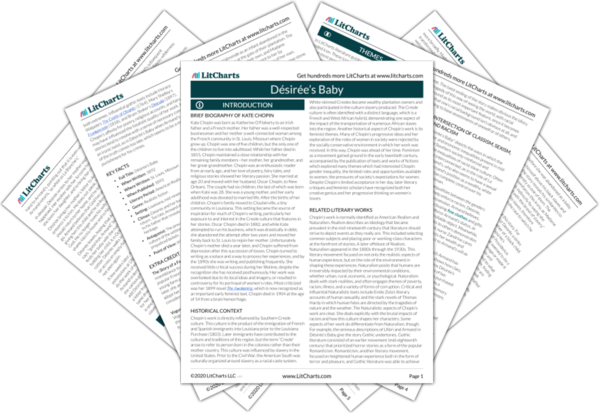Welcome to the LitCharts study guide on Kate Chopin's Désirée’s Baby. Created by the original team behind SparkNotes, LitCharts are the world's best literature guides.
Désirée’s Baby: Introduction
Désirée’s Baby: Plot Summary
Désirée’s Baby: Detailed Summary & Analysis
Désirée’s Baby: Themes
Désirée’s Baby: Quotes
Désirée’s Baby: Characters
Désirée’s Baby: Symbols
Désirée’s Baby: Literary Devices
Désirée’s Baby: Quiz
Désirée’s Baby: Theme Wheel
Brief Biography of Kate Chopin

Historical Context of Désirée’s Baby
Other Books Related to Désirée’s Baby
- Full Title: Désirée’s Baby
- When Written: 1892
- Where Written: St. Louis, Missouri
- When Published: 1893
- Literary Period: American Realism and Naturalism
- Genre: Realistic fiction
- Setting: Louisiana, mid-nineteenth century
- Climax: Désirée and her baby set off into the Bayou never to return. Too late, Armand discovers a letter from his mother to his father that reveals his, rather than Désirée’s, black heritage.
- Antagonist: The prevailing prejudice of the racist and sexist culture of the setting; Armand as a figure who holds these prejudiced beliefs
- Point of View: third-person omniscient
Extra Credit for Désirée’s Baby
The Story of a Farm Girl. Désirée’s Baby bears interesting resemblance to a short story called “The Story of Farm Girl” by popular French writer Guy de Maupassant. In this story, a young farm girl has a child with a lover who abandons her. Years later, she and her husband cannot have children, but are able to adopt her long lost child as their own. Chopin’s work is considered an intentional transposition of this text.
Vogue Magazine. Désirée’s Baby was initially published in Vogue Magazine. While contemporary readers might identify this publication primarily with popular fashion, Vogue was founded in 1892 (just before Chopin’s inclusion) as a publication to celebrate “the ceremonial side of life.” It catered primarily to New York aristocracy.







